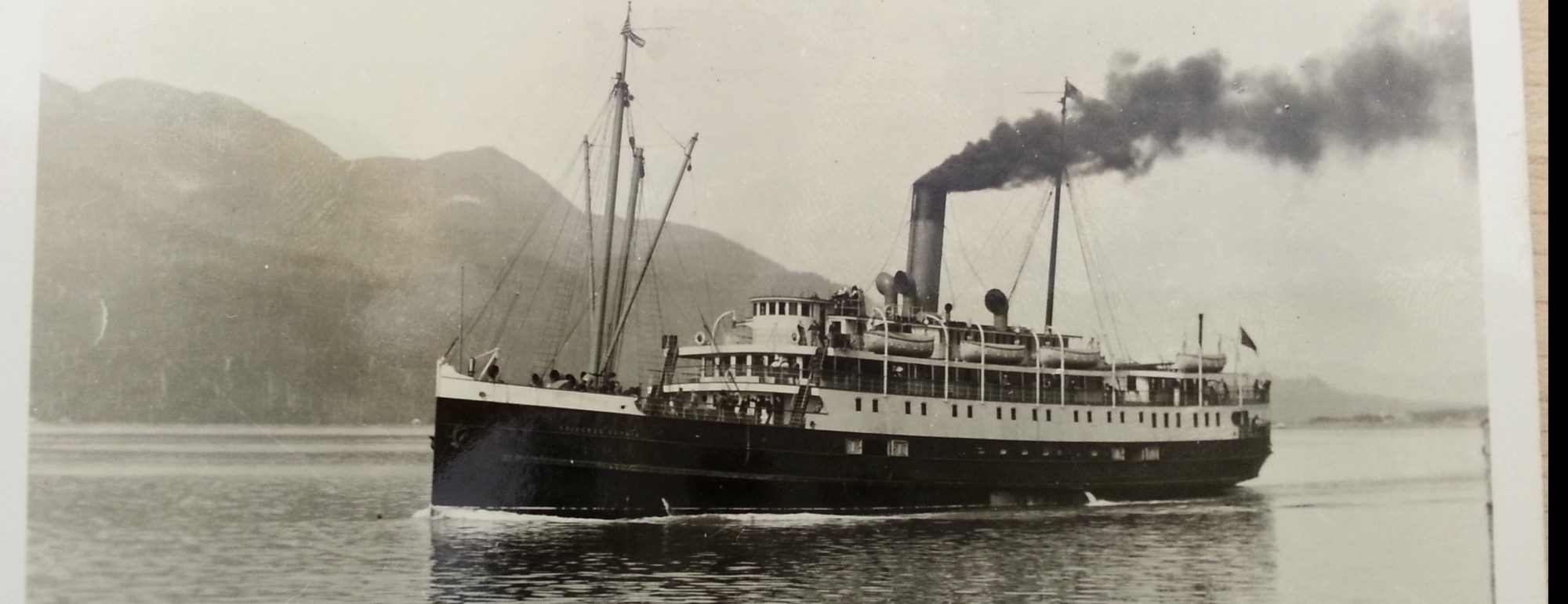Submerged in Memory
The Sinking in Cultural Context
“The name Princess Sophia remains forever engraved in memory as the victim of the most tragic maritime accident in the history of the Pacific Coast.”
– Clinton H. Betz1
Lost in Tragedies
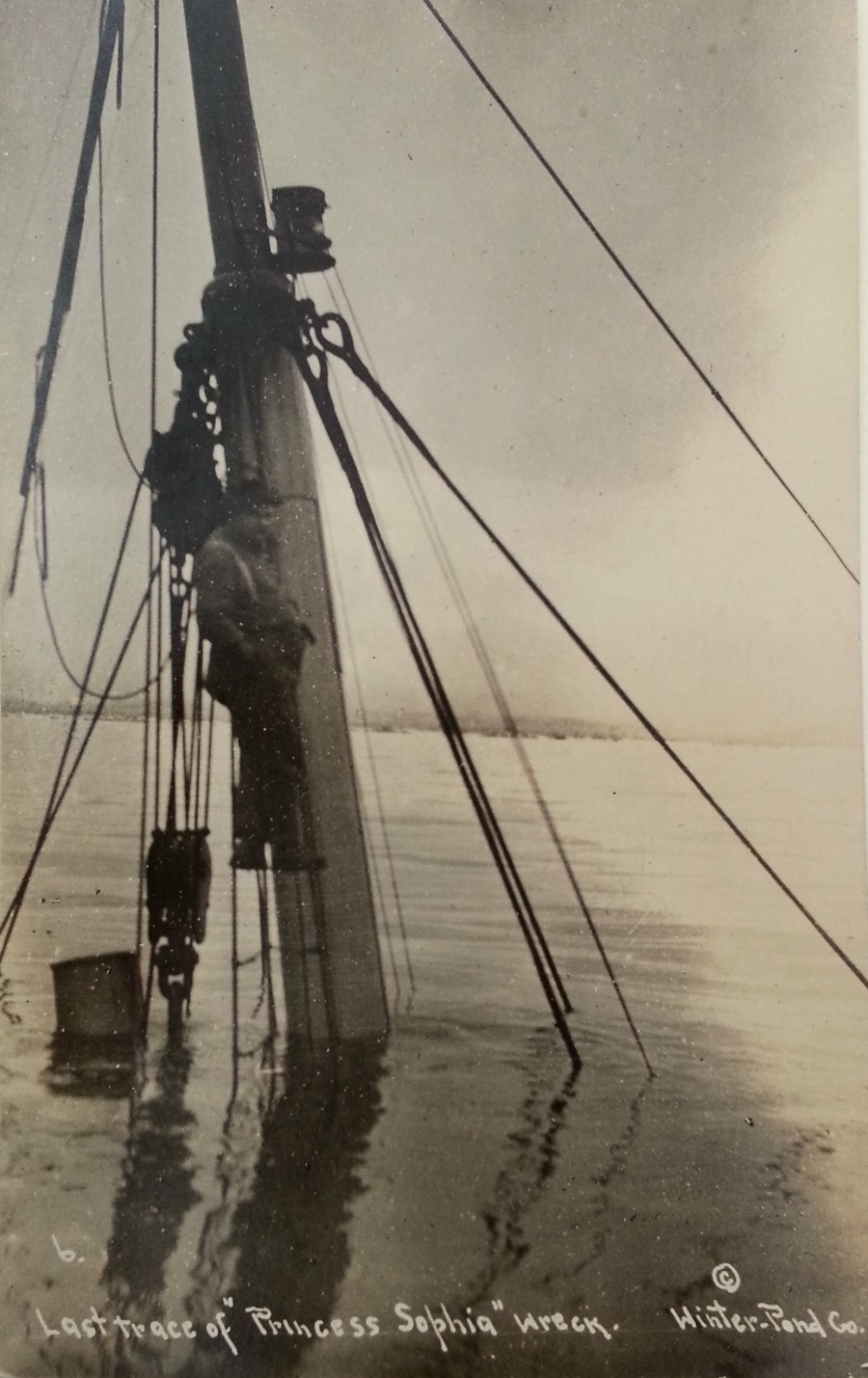 A crew member of one of the many rescue boats stands on the Sophia’s cargo mast, the only section of the vessel still above water on 26 October 1918.
A crew member of one of the many rescue boats stands on the Sophia’s cargo mast, the only section of the vessel still above water on 26 October 1918.
Though the sinking of the Princess Sophia may very well be the “most tragic maritime accident in the history of the Pacific Coast,” the fact remains that it is certainly not engraved in memory as anything of the sort. In fact, most people do not remember it at all. But the sinking was an enormous tragedy for those who experienced it, and did have a tremendous impact on a multitude of communities, including Victoria, Vancouver, Skagway, Dawson, and Juneau. The story of the sinking has all the makings of a Hollywood tragedy, and many parallels to the sinking of the infamous RMS Titanic. Bitterly cold waters, rescue ships that could not reach the doomed vessel in time, a captain who chose to plunge full speed ahead despite dangerous weather – the list goes on. Yet the sinking of the Sophia, far from being the subject of several blockbuster films and innumerable popular and academic books, has instead undergone yet another tragedy. The ship and her passengers have sunk once more, this time into the depths of popular memory. How could a tragedy of this scale have been so easily submerged in public consciousness? Why does the word Titanic instantly conjure up images of frigid, terrifying tragedy, while the word Sophia is met with nothing at all? The answer lies in the sinking’s cultural context.
On 25 October 1918, the world was at war. Families across the nation, and here in Victoria, were anxiously awaiting any word from loved ones overseas, and for a much-anticipated peace. The war, at first supposed to be over by Christmas of 1914, had dragged on for four long years, and the public was weary of death and tragedy. When the horrible news of the Sophia’s sinking reached Victoria on 27 October, the public had further cause to despair. But with the public eye riveted on news from the advancing front, the Sophia could only fight for public attention for so long before being washed away on the tide of increasing Allied victories.

Complicating the picture still further was the grip that the Spanish flu was taking across the nation, with its first cases appearing in Victoria earlier in October.2 The sickness was a blessing for some, as in the case of Archibald Alexander, the Sophia’s first engineer who had foregone the fateful voyage after rushing to Victoria on an earlier ship. His twin daughters had fallen ill with the flu, and in his hurry to reach them he miraculously managed to avoid a watery grave.3 But for most, the flu was a curse. As the pandemic’s death tolls continued to rise, the sinking of the Sophia became just another calamity among larger, more widespread tragedies.

In this context, it is little wonder that so many people were eager to celebrate, as was the case when news of the armistice reached the shores of the West Coast. In Vancouver, 11 November was declared a public holiday. Thousands of people took to the streets, turning the city into “a ‘Maelstrom of Laughing, Jubilant, Flag-bedecked Humanity’, with ‘Every Variety of Noise-making Apparatus Brought into Play’ to ‘Celebrate the Glorious Victory and Demonstrate Their Affection for [the] Gallant Boys Who Made It Possible.’”4 This was the same day that the Princess Alice, dubbed the “Ship of Sorrow,” steamed into Vancouver’s harbor, carrying the bodies of passengers aboard the Sophia who had been heading home. Already, the public was choosing joy over sorrow – and understandably so – but that decision would go on to contribute to an almost complete forgetting of the Sophia tragedy in the years to come.
Lost In Myth
The fate of the Sophia’s memory was inextricably intertwined with the memory of the Great War. Those who do remember it place it within the war’s context, not as a separate event. In an interview about his life working on shipping vessels along the West Coast, James Gardner recalls the event, but quickly contextualizes it for the interviewer: “Good near 100 [men he knew or had met] went down with her … That was during that war, you know.”5 Even contemporary actions reflected an interest in the Sophia’s relation to the war effort. In a letter to the Daily Colonist editor, Mr. Frank Slavin wrote of his experiences working in the Yukon and passed on his sympathies to the grieving families of the victims. It seems he was unable to keep the Sophia sinking and the war effort separate, however, as he felt the need to end his condolences with: “It is a great satisfaction to old Yukoners that that corner of our immense Empire has contributed a larger percentage of men to help keep the grand old flag flying than any other more favored spot, having sent over 2,000 men out of a population of less than 10,000.”6 Furthermore, the ship had been carrying Christmas packages for soldiers at the front, and all of them were lost when she foundered. Citizens of Courtenay, upon hearing this, wired Dawson City’s postmaster: “If you will wire names and addresses of boys at front whose parcels were lost on Sophia the people here will forward them parcels for Christmas.”7 Although families of the Sophia victims did receive floral tributes, it appears as though these were mostly from family friends, and not a result of a wide-scale public response.8
The civilian need to help the war effort in any way possible carried over into the post-war era. Following the end of the Great War, people needed to believe that their sacrifices had meant something. In order to assist the grieving process, the war “had to be recalled in such a way that positive outcomes were clear,” not just in private memory, but also in historical writing.9 The official Canadian history of the war was not released until 1938, but Canadians were not willing to wait 20 years to have the war officially explained. In response to this need for historical memorialization, regimental histories were written and published. Focusing largely on the stories of individual regiments, these histories formed most of the early historical works on the war.10 They were meant to be part of the healing process, “a source of consolation to the proudly sorrowing hearts of those whose nearest and dearest fell fighting in the war.”11 They resonated with “commemoration and sacrifice, comradry and loss,”12 and provided the public with what they wanted: stories of adventure and romance, not tragedy.13

In contemporary writings, the war itself was cast as a meaningful struggle against, in the words of Lt. Col. L. Moore Cosgrave, a Canadian veteran of the conflict, “fiends in human form who … could violate … all the tenets and creeds of a humane world!”14 He says that the soldiers “were pledged to destroy for humanity’s sake,”15 and asks that civilians do their part to remember the war in a way that reaffirms the glory and meaningfulness of mass death, and not to perpetuate the tragic aspects of it. Writing in the third person, he wondered: “if the world would ever be grateful for the sacrifices of the million soldier-men such as he, and the super-sacrifice of those other millions of soldier-men who had passed beyond the wondering stage.” He decides that the world would remember, and that together civilians and veterans would, through their remembrance, make the world “as we [soldiers] sometimes picture it in our dreams – all happiness, content and joy, and … the million anxious dead of all the nations will rest tranquil and serene beyond the veil.”16 Cosgrave and other soldiers urged the public to remember the war, and thus mass death, a certain way.17 To do otherwise, it was implied, would negate all that the soldiers had fought and died for.
It was between these two pillars of memory that the story of the Sophia sinking was forced to navigate. On one side, the soldiers urged civilians to remember the war as glorious and meaningful, while on the other, civilians demanded adventure and excitement over disaster and grief. Dawson city, in the Yukon, seems to have innately recognized the need to steer the Sophia’s story along these themes. Victoria, on the other hand, did not. This may help explain the difference between the Yukon’s memory of the Sophia and Victoria’s. At first, the tale of the sinking was told by Dawson newspapers in such a way as to conform to the civilian’s demands. The press searched for stories of heroism amongst the victims, landing on two in particular, in an attempt to bring the tragedy in line with the larger themes of valour and glory that the public had come to expect from newspaper reporting. Victoria newspapers do not appear to have taken this route, instead lamenting the tragedy and telling how it came to pass without reflecting much on larger themes.
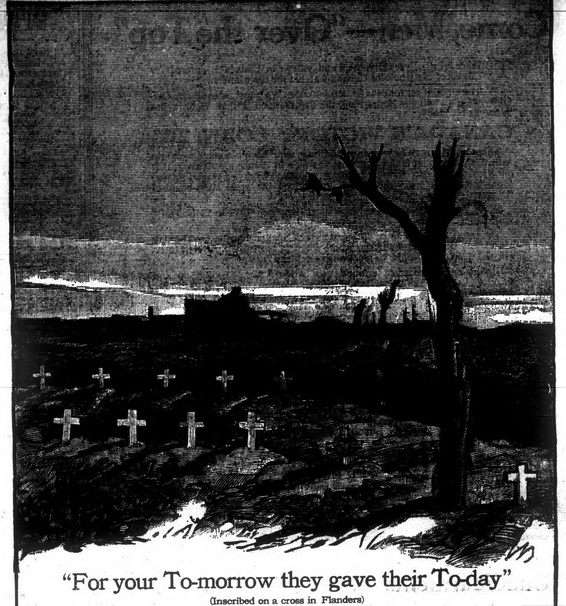 This Victory Bond advertisement reflects the widespread need to associate death with something meaningful – in this case, sacrifice on behalf of civilization.
This Victory Bond advertisement reflects the widespread need to associate death with something meaningful – in this case, sacrifice on behalf of civilization.
In Dawson, a community which arguably suffered the most from the sinking, it is estimated that approximately one in ten of the town’s citizens went down with the ship.18 The Dawson Daily News immediately worked to glorify the Sophia victims, highlighting their bravery and nobility in much the same way as soldiers of the Great War were idealized. The close-knit nature of the community made everyone feel a heavy loss, with the paper saying “the intimacy and esteem of those who were called [to heaven] and those who remain was like unto that of a family.”19 In the special memorial issue of the newspaper, victims were praised as “sterling citizenry” who were enshrined in memory as “of the best of the breeding of a land whose signal trait is dauntless courage in the face of greatest trials.” The article heroicized the victims, and went on to reflect the larger themes of patriotic courage and nation building that were common in writings on the Great War:
The tradition of the Yukon, it can be depended upon, suffered no tarnishment but rather was glorified by heroic acts in those last moments. If the tale of the individual considerations could be recited, if the stories of refusals of opportunities to be first to take the best facilities for attempting to make shore through those wild seas could be told today, no doubt they would reflect as true tokens of heroism as ever came from the seas. Yukoners will cherish the belief that not even … the supreme sacrifices of the noble souls who stood back and perished when the Titanic went down could have been more noble than that of the un-named heroes and heroines of the Sophia. No doubt the tradition of honor and courage which signalize the people of the Northland was theirs until the end, and if the tale were known in full it would crown an epic theme. Now that they have passed through the storm to the large portals of another world, Yukon can cherish the conviction, earth knew no nobler souls.20
For Dawson, the sinking was a terrible tragedy that affected the entire community, but it also provided an opportunity to espouse the strength and courage of the ‘great white North.’ The nationalistic overtones in the piece create a direct link to the way that the Great War was portrayed in popular writing, helping to cement the Sophia within a larger narrative.
Dawson also found stories of heroism among the victims, especially in the case of James Kirk, a 50 year old Dawson resident who had tied himself to the wrist of a younger man in an attempt to swim both of them to shore.21 Papers hailed him as “one of the most heroic, if not the most heroic man, of the Sophia wreck.”22 The story of young Bobby O’Brien and his father was also published to tug at public heartstrings, with an Alaskan paper saying that the boy’s body was found “clasped tight in his father’s arms.”23 In reality, their bodies were found months apart. Stories like these show the need to bring the sinking in line with the greater narrative themes made popular in telling the story of the Great War, and that Dawson recognized this need and worked to tell the story accordingly.
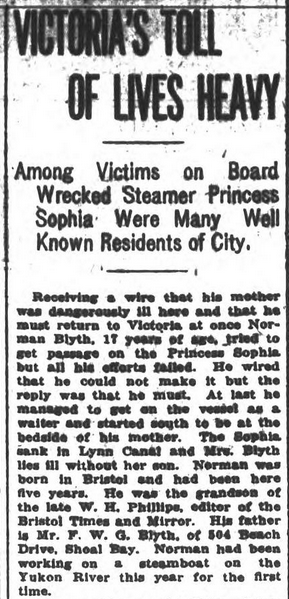 The Daily Colonist reported on local victims of the Sophia tragedy on 30 October. Norman Blyth’s story was one of the few human interest stories published in the aftermath of the sinking, and emphasizes the sinking’s tragic aspects.
The Daily Colonist reported on local victims of the Sophia tragedy on 30 October. Norman Blyth’s story was one of the few human interest stories published in the aftermath of the sinking, and emphasizes the sinking’s tragic aspects.
In Victoria, the story suffered a different fate. Though Victorian newspapers did provide developing reports on the sinking, the pieces do not seem to have had the same effect. The number of victims from Victoria were significantly fewer than the number of Dawson citizenry, and although the paper did work to link the victims to the wider community,24 these pieces were few and far between, and did not take as much precedence within the sinking’s narrative as can be seen in the Dawson newspaper. Though one public interest story could certainly have been written – that of Frank Gosse, a Victoria resident who was the only person to make it to shore – the paper seems to have missed this opportunity. While the Daily Colonist does cursorily cover the fact that he was the only man to make it to shore, this is included only as a footnote to the arrival of the Princess Alice and the victims’ bodies. Press coverage of Bobby O’Brien and his father similarly worked only to emphasize the tragedy of the sinking, with no clear connection to nobility or heroism. Other press coverage of the victims included only biographical information. While some did attempt to remember the sinking as relating to larger themes of glory and heroism, as is the case in one memorial poem written on 30 October 1918 by Louise Shrapnel Keith, these efforts were marginalized by the many articles that sought only to relay the main details and tragic tone of the sinking. With no overarching themes to link the sinking to, the story soon disappeared from the papers, resurfacing only when new developments took place.
The emergence of new, disheartening information about the sinking in Victoria newspapers further complicated the public’s decision to remember or forget the tragedy. This is partly because mass death in the wake of the Great War needed to be remembered as meaningful and uncomplicated. The past needed to be communicated in a “pure, unambiguous, and simple fashion,”25 which would allow for the continuance of the Great War myth. The myth had become so important to Canadians that they “were not willing to sit idly by while it was undermined. To do so was to dishonour everything they held dear about the war.”26 With the public willing to do whatever it took to protect their version of the war, and thus their understanding of mass death, the memory of the Sophia sinking needed to be retooled or removed altogether from public consciousness. The public story of the sinking, at first supposed to be brought in line with the themes of the Great War myth, was proving an obstacle to the “pure” and “simple” memories that civilians craved. In fact, the entire story of the sinking was in direct conflict with the myth that the public sought to protect.
Nothing about the Sophia tragedy was “pure,” “unambiguous,” or “simple.” The ship had sunk unexpectedly, with Victorian citizens being told one day that “no loss of life or boat is feared,”27 and the next that the ship had been “lost with all hands.”28 Citizens’ nerves were already strained after four years of war. A shock of this nature could not have been taken well. Knowing that rescue ships had been close by, but could offer no assistance, further complicated the story. Making it even worse was the mystery that arose surrounding how fast the ship sank. There were a great many bodies found below decks, and passengers’ watches had stopped once they hit the seawater at 6:20, a full hour after David Robinson had radioed the Cedar in a panic, pleading “Please hurry – the water’s coming into my room.”29 Why was a call to evacuate the Sophia not sounded? Why did people take refuge within the sinking ship, rather than chance survival in a lifeboat? That the course of events surrounding the actual foundering of the ship remained ambiguous meant that the story of the sinking could not be easily submersed within the simple story of the past that the Great War myth sought to tell. Its mysteries, which would normally make the sinking memorable, were the reason it had to be forgotten.
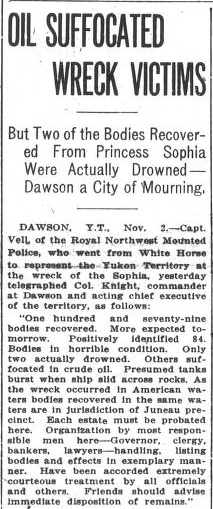 On 3 November, Victoria’s citizens learned the horrible truth of how the Sophia victims died.
On 3 November, Victoria’s citizens learned the horrible truth of how the Sophia victims died.
As newspapers published more and more details of the sinking, the story became one that simply could not be accommodated within the newly developing myth of the Great War. Where the mass death caused by the Sophia’s sinking was a meaningless and unexpected catastrophe experienced by ordinary people with only a few ties to the city of Victoria,30 the mass death of Victorian troops overseas, all of whom represented the community and could be hailed as local heroes, was meaningful and, after years of attrition warfare, expected. Though citizens were aware that deaths in the war were oftentimes grisly or unpleasant, they could reconcile this knowledge with the idea that a soldier choking on gas was doing so for a meaningful cause. Sophia passengers choking on oil, however, could not be linked to any larger purpose. Though the sinking was undoubtedly tragic, it was still an essentially meaningless event of mass death. To the grieving families of the many victims from Victoria, the sinking of course held all the meaning in the world. But to those who had no connection to the victims, prolonged collective remembrance of the Sophia tragedy was dangerous. The public could not remember mass death as meaningless, as in the case of the Sophia, while at the same time remember it as meaningful, as in the case of the Great War. When forced to choose, they chose the war. The scope and scale of both events meant that the Sophia simply could not compete.
The Sophia’s memory mounted another attack on the myth of the Great War when the Princess Alice sailed south to deliver the victims’ bodies to their homes. Over the course of the Great War, civilians had experienced soldiers’ deaths as corpselesness, as all of the deceased soldiers were buried in cemeteries in Europe. This allowed civilians to maintain their ideals of noble and heroic death.31 In fact, “civilians actually took pains to ensure that their home-front landscape remained free of corpses, populated by bright images of glory which propaganda certainly supplied and encouraged but which families took up with equal enthusiasm.”32 When the bodies of the Sophia victims arrived, the illusion that civilians were working to uphold was shattered. Forced to confront actual bodies, the likelihood that they would not make the connection between this mass death and the perpetual death of soldiers overseas is essentially nonexistent. Faced with accepting this grisly reality or maintaining their idealized visions of valiant soldiers dying gallantly for their country, civilians chose the latter. In doing so, they rejected the memory of the Sophia sinking, leaving the victims’ relatives to collect their bodies and mourn them in private.
The return of the victims’ bodies also allowed for a close to the grieving process. Since families had their loved one’s physical remains, they could bury them, grieve, and begin to move on with their lives. This was more difficult to do for the families of soldiers who had died overseas. These families, denied of the closure that a body would bring, had nothing but a condolence telegram, a gravesite location somewhere in Europe, and the soldier’s belongings to mourn them by. The Sophia victims, however, did not receive a memorial in Victoria, while a great many are dedicated to the soldiers of the Great War. Even the Galiano, the only Canadian naval ship to be lost during the Great War, received two memorials: one in Esquimalt and one in Ross Bay Cemetery.33 Though numerically the Galiano tragedy paled in comparison to that of the Sophia – 40 souls were lost when the Galiano sank off the Queen Charlotte Islands, a victim of the same storm that doomed the Sophia – what the Galiano stood for was something the Sophia could not: yet another tragic Canadian contribution to the war effort. The Galiano had been conducting naval duties, and its crew was comprised of volunteer naval servicemen. Thus its sinking became a component of the Great War myth, deserving of memorialization, while the Sophia was left to be mourned privately. Some of the victims’ gravesites seem to compensate for this, citing the S.S. Sophia or the Princess Sophia on their gravestones as a token of solidarity. Listing the cause of death on a grave marker in this period was rare, so it is likely that this was a small effort at memorialization among the victims’ families.34
Although the victims’ families did at first receive an outpouring of support and condolences from their communities, that support was short-lived. The end of the war meant an end to the Sophia’s run as a headlining story. As news of victory filled the papers and people had reason to rejoice again, the Sophia tragedy slipped out of public notice, and its victims slipped out of the public’s commemorative efforts. As the public returned complete focus to the war’s end, and began to work with historians to perpetuate the Great War’s myth, the Sophia sinking was expunged from the annals of history. In the months and years that followed, the story of the Princess Sophia sank further and further into the depths of public consciousness, a victim of civilians’ needs to protect the myth of the Great War and the ideal of glorious, meaningful death.

“Were it not for this world conflict the loss of the Princess Sophia, with all on board, would be chronicled around the world as one of the greatest disasters in marine history. The losses in this disaster may seem to the general public trivial, but to us who know many of the victims it is not so.”
– Bishop Stringer of Bonar Presbyterian Church, Toronto, Ontario. He was friends with many of the men and women aboard the Sophia, and commemorated their loss in a sermon he gave to his church.35
1. Clinton H. Betz, “The Princess Sophia of the BC Coast Steamship Service: Part 2,” In the Sea Chest: Journal of the Puget Sound Maritime Historical Society 26, no. 2 (December 1991), 88.↩
2. Kira Gebauer, “Spanish Influenza Timeline,” Spanish Influenza in Victoria, https://onlineacademiccommunity.uvic.ca/spanishflu/fluvictoria/spanish-influenza-timeline/ (accessed 7 April 2014).↩
3. Ken Coates and Bill Morrison, The Sinking of the Princess Sophia: Taking the North Down With Her (Toronto: Oxford University Press, 1990), 55.↩
4. Vancouver Sun, 12 November 1918, quoted in Coates and Morrison, The Sinking of the Princess Sophia, 122↩
5. British Columbia Archives, Imbart Orchard Records, Description Number: AAAB1352, Call Number: T1223:0002, Captain Joseph Alphonsus Gardner: Recollections of a Riverboat Man, 1895-1950: part 2.↩
6. Daily Colonist, 10 November 1918, 12.↩
7. Coates and Morrison, The Sinking of the Princess Sophia, 127.↩
8. Daily Colonist, 17 November 1918, 18.↩
9. Jonathan F. Vance, Death So Noble: Memory, Meaning, and the First World War (Vancouver: UBC Press, 1997), 9.↩
10. Tim Cook, “Quill and Canon: Writing the Great War in Canada,” The American Review of Canadian Studies 35, no.3 (Autumn 2005), 518, 509.↩
11. Tim Cook, “Quill and Canon,” 508.↩
12. Tim Cook, “Quill and Canon,” 508.↩
13. Tim Cook, “Quill and Canon,” 514.↩
14. Lt.-Col. L. Moore Cosgrave, D.S.O., Afterthoughts of Armageddon: The Gamut of Emotions Produced by the War, Pointing A Moral That is Not Too Obvious (Toronto: The Hunger-Rose Co., 1919), 14.↩
15. Cosgrave, Afterthoughts, 19.↩
16. Cosgrave, Afterthoughts, 34-35.↩
17. George L. Mosse, Fallen Soldiers: Reshaping the Memory of the World Wars (New York: Oxford University Press, 1990), 6.↩
18. Coates and Morrison, The Sinking of the Princess Sophia, 124.↩
19. Dallas Daily News, quoted in Coates and Morrison, The Sinking of the Princess Sophia, 125.↩
20. Dallas Daily News, 7 November 1918, quoted in Coates and Morrison, The Sinking of the Princess Sophia, 125-126.↩
21. Coates and Morrison, The Sinking of the Princess Sophia, 97.↩
22. Dallas Daily News, quoted in Coates and Morrison, The Sinking of the Princess Sophia, 97.↩
23. Victoria Times, 30 October 1918, 15.↩
24. See Daily Colonist, 31 October 1918, 1,5; Daily Colonist, November 17 1918, 17.↩
25. Vance, Death So Noble, 8.↩
26. Vance, Death So Noble, 197.↩
27. Daily Colonist, 25 October 1918, 14.↩
28. Daily Colonist, 26 October 1918, 1.↩
29. Coates and Morrison, The Sinking of the Princess Sophia, 95.↩
30. Meaningless in terms of death on behalf of a ‘noble’ or ‘good’ cause. Death itself is never meaningless, and the deaths of the Sophia victims was certainly not meaningless to those who the tragedy affected directly.↩
31. Allyson Booth, “Figuring the Absent Corpse: Strategies of Representation in World War I,” Mosaic 26, no.1 (Winter 1993), http://go.galegroup.com/ps/i.do?id=GALE%7CA14332177&v=2.1&u=uvictoria&it=r&p=CPI&sw=w&asid=abb7c6f52d24e5ca510126a4cb6c5db0.↩
32. Booth, “Figuring the Absent Corpse.”↩
33. Stephen Rybak, “The Wreck of HMCS Galiano 1918,” Nauticapedia.ca 2012, http://www.nauticapedia.ca/Articles/Rybak_Galiano_Wreck.php, (accessed 7 April 2014).↩
34. Coates and Morrison, The Sinking of the Princess Sophia, 136.↩
35. Coates and Morrison, The Sinking of the Princess Sophia, 131.↩
